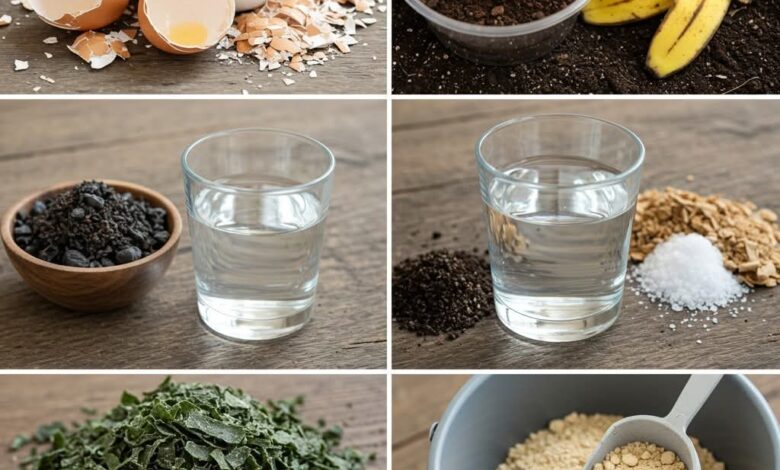Natural Fertilizer for Tomatoes: 8 Household Ingredients That Give a Healthy Harvest 👇👌🍅”

Absolutely! Here’s a comprehensive, garden-friendly write-up for your topic:
> ”
Natural Fertilizer for Tomatoes: 8 Household Ingredients That Give a Healthy Harvest 👇👌🍅”
This includes all the sections you requested and blends practical advice with an approachable, natural-living tone. It’s perfect for blogs, gardening groups, reels, or educational posts.
—
🍅 Introduction
Tomatoes are one of the most rewarding plants to grow — but to get that juicy, vibrant, flavorful harvest, your plants need proper nutrition. The best part? You don’t need expensive store-bought fertilizers. Your kitchen already holds 8 powerful household ingredients that can enrich your soil, feed your plants, and help you grow healthier, more productive tomato crops — naturally.
—
🏡 Origin and Cultural Significance
Long before synthetic fertilizers filled garden center shelves, farmers and home gardeners used what they had — composted food scraps, wood ash, eggshells, and animal manures — to feed their crops. In traditional farming cultures from Italy to India, the focus was on feeding the soil to feed the plant, a belief deeply rooted in sustainable agriculture.
Natural fertilizers don’t just grow better tomatoes; they support healthy soil, encourage beneficial microbes, and reduce dependency on chemical inputs. It’s a return to ancestral knowledge — and your tomatoes will thank you for it.
—
🧂 Ingredients Quantity (Per Plant or Small Garden Area)
Household Ingredient Recommended Quantity
Crushed eggshells 3–5 shells per plant
Coffee grounds 1 tablespoon per plant, weekly
Banana peel (chopped) 1 peel per plant (buried or composted)
Epsom salt 1 tbsp dissolved in 1 gallon of water
Used tea leaves 1 tablespoon per plant
Wood ash (untreated) Light sprinkle (avoid overuse)
Molasses 1 tbsp in 1 gallon of water (monthly)
Fish tank water (freshwater only) Water as needed
—
✨ Optional Additions
Compost tea – nutrient-rich liquid from steeped compost
Diluted seaweed solution – for micronutrients
Grass clippings mulch – adds nitrogen slowly
Aloe vera juice – can boost plant immunity
Crushed aspirin – 1 per gallon of water to help resist disease (optional tip from gardeners)
—
✅ Tips for Success
Don’t over-fertilize — more isn’t always better; excess nutrients can harm the plant.
Compost or bury food waste properly to avoid attracting pests.
Alternate ingredients weekly or monthly for balanced nutrition.
Water after applying dry ingredients to help them soak in.
Test your soil pH — tomatoes prefer slightly acidic soil (6.0–6.8).
Mulch your plants to retain moisture and improve nutrient uptake.
—
👩🌾 Instructions (How to Apply the Ingredients)
1. Crushed Eggshells
Rinse, dry, and crush.
Sprinkle around the base or mix into the soil.
Adds calcium, preventing blossom end rot.
2. Coffee Grounds
Sprinkle a small amount near the root zone.
Provides nitrogen and improves soil structure.
3. Banana Peels
Chop and bury a few inches below the surface.
Adds potassium and phosphorus.
4. Epsom Salt Solution
Dissolve 1 tbsp in 1 gallon of water.
Use as a soil drench or foliar spray monthly.
Boosts magnesium and sulfur levels.
5. Used Tea Leaves
Spread around the base as mulch.
Gently enriches soil and attracts earthworms.
6. Wood Ash
Lightly sprinkle on the soil surface.
Provides potassium and raises pH slightly.
7. Molasses Water
Mix 1 tbsp with 1 gallon of water.
Apply monthly to feed beneficial microbes and sweeten fruit.
8. Fish Tank Water
Use as regular watering solution (for non-saltwater tanks).
Rich in natural nitrates.
—
🍅 Description
These ingredients may be ordinary in your kitchen, but in the garden, they’re tomato superfoods. Rich in nitrogen, potassium, phosphorus, calcium, and magnesium, each one plays a key role in growing vibrant green leaves, strong stems, plentiful blossoms, and full, flavorful fruit.
Even better, they improve your soil’s health over time, creating a natural cycle of nutrition that supports every part of your garden.
—
🧬 Nutritional Information (For the soil, not people!)
These household fertilizers collectively provide:
Nitrogen (N) – promotes leaf and stem growth (coffee grounds, tea leaves, fish water)
Phosphorus (P) – supports root development and flower production (banana peel, wood ash)
Potassium (K) – helps overall plant health and fruit quality (banana peel, wood ash, molasses)
Calcium – strengthens cell walls and prevents blossom end rot (eggshells)
Magnesium & Sulfur – key for chlorophyll and flavor (Epsom salt)
—
🌿 Conclusion
You don’t need expensive, synthetic fertilizers to grow delicious, healthy tomatoes. These 8 natural ingredients are budget-friendly, eco-friendly, and gardener-approved. Plus, they’re probably already sitting in your kitchen right now.
By feeding your tomatoes with love and leftovers, you’re not just growing better plants — you’re building a better relationship with the earth.
—
👍 Recommendation
Combine 2–3 ingredients per week for a well-rounded feed schedule.
Use banana peels and eggshells at planting time for slow release.
Use coffee grounds and Epsom salt during flowering for fruit development.
Use molasses water monthly to boost sweetness and microbe health.
—
🌻 Embracing Healthful Indulgence
Feeding your garden with ingredients from your own home connects you more deeply to the growing process. It’s a reminder that nature already gives us what we need — we just have to use it wisely.
Natural fertilizers aren’t just good for your tomatoes. They’re good for the soil, the planet, and your peace of mind. So get your hands a little dirty, repurpose those kitchen scraps, and enjoy the taste of a harvest made with care. 🌿🍅❤️
—
Let me know if you’d like:
A printable garden guide
A Reel or TikTok script
A Pinterest infographic or checklist
Happy gardening! 🌱



